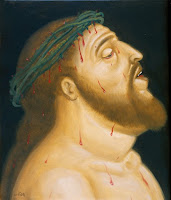That victory for historicity got me thinking about all the other false depictions of Jesus. As an overweight person, I notice that Jesus doesn’t look like me. (Note my tongue in my cheek) The adult Jesus is always pictured as trim and handsome. The popular television series The Chosen is the most recent perpetuation of this myth. Where does the Bible ever say that Jesus was thin and good-looking?
The “suffering servant,” passage in Isaiah, which is thought by Christians to be a messianic prophecy, says the opposite. In the context of him growing up, it reads: “He had no beauty or majesty to attract us to him, nothing in his appearance that we should desire him.”
If this is a prediction of how Jesus looked all his life and not just on the cross, this means that Jesus was not attractive. Yet he is never pictured this way. Why? Because no one wants an ugly Jesus. If Jesus were portrayed in films as unsightly, no one would watch them. In fact I am sure there would be outrage from the Christian community.
The same would be true if Jesus were depicted as overweight. I have never seen Jesus portrayed as heavy in any film, picture, or painting, until I did an internet search before writing this article. Then I discovered the Columbian artist Fernando Botero. His work is refreshingly original and challenges our stereotypes. I include his “Head of Christ” with this article.
Why is Jesus never portrayed as obese? Would he not still be the Son of God if he carried a few extra pounds? It is because obesity is considered unattractive in our weight-conscious culture. We prefer Jesus to conform to our cultural ideals. So we sing: “Beautiful, beautiful. Jesus is beautiful. And Jesus makes beautiful things of my life.” No one wants a portrait of a fat Jesus hanging in their church.
Yet in the gospels Jesus’ opponents described him as “a glutton and winebibber.” They were accusing him of overeating! Many of the parables of Jesus are about parties and banquets. His first miracle was turning water to wine at a wedding feast. In another famous miracle he fed 5000 people and had food left over. He liked that miracle so much he did it again with a group of 4000! The most important ritual of the church involves eating. Jesus loved to eat and drink! It is not unreasonable that his love of food showed in his body shape.
Also Jesus is often pictured groomed and washed – all ready to attend church. He looks more like a model for a hair shampoo commercial than a homeless itinerant preacher. Yet Jesus said that he “had no place to lay his head.” In other words he lived rough. That means it was probably a challenge to keep clean and well-groomed.
As far as his physique is concerned, Jesus is never pictured as muscular. Stallone and Schwarzenegger were never offered the role of Jesus in a film. I just finished watching the television series “Reacher.” The star of the show, Alan Ritchson, has the physique of a body-builder. I am pretty certain that he is not going to be cast as Jesus anytime soon.
But the gospels say Jesus was a “builder.” This is usually translated as a carpenter, but he was more likely a stonemason. There are very few trees in the Holy Land, but there are lots of rocks. Builders in that time and place worked more with stone than wood.
Jesus was a stonemason when there was no heavy machinery to help move the stones. All the work was done with human labor. Jesus was a laborer in an occupation that demanded great physical strength. He was almost certainly a large muscular fellow.
So was Jesus fat? Probably not. He burned too many calories. He worked too hard during this career as a builder and walked too much during this career as a wandering preacher. But I imagine him as a big guy.
In short Jesus did not look like a light-skinned, light-haired, blue eyed, trim, handsome, well-dressed megachurch pastor. Jesus looked like a large, muscular construction worker, with dark skin, dark hair, and dark eyes. He was probably unattractive to look at. He would not be chosen for The Bachelor reality show.
But you will not see Jesus depicted in this way in Christian art or film. That would not sell the product that the modern church is selling. So the church ignores all historical evidence about Jesus and crafts an alternate image of Christ to conform to our cultural stereotypes in order to compete in the religious marketplace. After all, you’ve got to fill the pews and the offering plates!
I prefer the historical Jesus. It does not matter to me what he looked like. I think he is beautiful, even though he may have not been attractive by worldly standards. In fact I think the ordinariness of the historical Jesus is an advantage. It forces us to look beneath the surface of every person we meet. If Jesus was ordinary, then we are more apt to love ordinary neighbors – and strangers - with the same love that we love Jesus. For as we treat the least of our human brothers and sisters, so we treat Christ.










